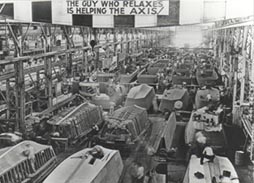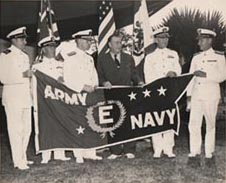Founder and president of this remarkable company was Andrew Jackson Higgins, an outspoken, rough-cut, hot-tempered Irishman with an incredible imagination and the ability to turn wild ideas into reality. He hated bureaucratic red tape, loved bourbon, and was the sort who tended to knock down anything that got in his way. To the Navy's Bureau of Ships, which favored the big Eastern-seaboard shipyards, Higgins was an arrogant small boat builder from the South - a thorn in its side. To the Marine Corps, which desperately needed an effective amphibious assault craft, he was a savior.
Higgins rose to international prominence
 during World War II for his design and mass production of naval
combat motorboats - boats that forever changed the strategy of modern warfare.
Thanks to Higgins, the Allies no longer had to batter coastal forts into
submission, sweep harbors of mines, and take over enemy-held ports before
they could land an assault force. "Higgins boats" gave them
the ability to transport thousands of men and hundreds of tons of equipment
swiftly through the surf to less-fortified beaches, eliminating the need
for established harbors.
during World War II for his design and mass production of naval
combat motorboats - boats that forever changed the strategy of modern warfare.
Thanks to Higgins, the Allies no longer had to batter coastal forts into
submission, sweep harbors of mines, and take over enemy-held ports before
they could land an assault force. "Higgins boats" gave them
the ability to transport thousands of men and hundreds of tons of equipment
swiftly through the surf to less-fortified beaches, eliminating the need
for established harbors.
Higgins designed and produced two basic classes of military craft. The first class consisted of high-speed PT boats, which carried antiaircraft machine guns, smoke-screen devices, depth charges, and Higgins-designed compressed-air-fired torpedo tubes. Also in this class were the antisubmarine boats, dispatch boats, 170-foot freight supply vessels, and other specialized patrol craft produced for the Army, Navy and Maritime Commission.
The second class consisted of various types of Higgins landing craft (LCPs, LCPLs, LCVPs, LCMs) constructed of wood and steel that were used in transporting fully armed troops, light tanks, field artillery, and other mechanized equipment and supplies essential to amphibious operations. It was these boats that made the D-Day landings at Normandy, Guadalcanal, Tarawa, Iwo Jima, Okinawa, Leyte and Guam and hundreds of lesser-known assaults possible. Without Higgins' uniquely designed craft there could not have been a mass landing of troops and material on European shores or on the beaches of the Pacific islands, at least not without a tremendously higher rate of Allied casualties.
As late as 1930 Higgins was involved in the
 lumber importing and exporting business. By 1940 he was
producing workboats and prototype landing craft in a small warehouse located
behind his St. Charles Avenue showroom. When the government began ordering
his craft for military purposes, Higgins expanded into eight separate plants
in the city, employing more than 20,000 workers. At the peak of production,
the combined output of his plants exceeded 700 boats a month. His total
output for the Allies during World War II was 20,094 boats, a production
record for which Higgins Industries several times received the Army-Navy
"E", the highest award that the armed forces could bestow upon a company.
lumber importing and exporting business. By 1940 he was
producing workboats and prototype landing craft in a small warehouse located
behind his St. Charles Avenue showroom. When the government began ordering
his craft for military purposes, Higgins expanded into eight separate plants
in the city, employing more than 20,000 workers. At the peak of production,
the combined output of his plants exceeded 700 boats a month. His total
output for the Allies during World War II was 20,094 boats, a production
record for which Higgins Industries several times received the Army-Navy
"E", the highest award that the armed forces could bestow upon a company.
Higgins was the ideal person for the needs of the time. In World War II, with its massive contracts, his strengths - design and rapid production - were all-important. Administrative weaknesses were suddenly irrelevant - the war offered him opportunity. Had the Japanese not bombed Pearl Harbor, Higgins probably would have remained a successful, but small, southern boat builder. Because of the war, he rapidly became an internationally known figure (even Hitler was aware of Higgins, calling him the "new Noah").
In his 1944 Thanksgiving Day address to the nation, General Dwight D. Eisenhower said "Let us thank God for Higgins Industries, management, and labor which has given us the landing boats with which to conduct our campaign." Andrew Jackson Higgins' influence on amphibious warfare and his contribution toward the Allied victory in World War II cannot be overstressed.
|
|
RECOMMENDED READING ANDREW JACKSON HIGGINS AND THE BOATS THAT WON WORLD WAR II ISBN 0-8071-1903-2 LOUISIANA STATE UNIVERSITY PRESS Frontispiece: Andrew Jackson Higgins sits aboard one of his PT boats |
|
|
[Links] |
|
E-Mail: info@higginsboat.org |
